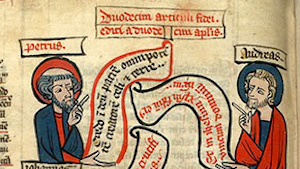In one of my seminary classes, the readings focused on the Sacrament of Baptism and its importance to the first century Christian Church. In connection to this, I also learned about the historic creed called the Apostles’ Creed, whose roots are intrinsically tied to baptism. As those early baby Christians left their Jewish roots, or Roman or Greek pagan religions, and claimed faith in Jesus Christ through baptism, they were asked to declare what they believe, taught to them according to the oral traditions and writings of the apostles. Long before the end of the second century, this statement of faith—also called the Rule of Faith at the time, or the “Baptism Symbol” (Symbol here meaning “summary”)—took the shape of a non-negotiable statement of belief upon which these new Christians were willing to stake their very lives. Over the course of the next few decades, this statement (or group of statements) took the form of the Apostles’ Creed as we know it today. Essentially, it is the earliest statement of faith that Christians ever made. Here is the Apostles’ Creed:
I believe in God the Father almighty, creator of heaven and earth.
I believe in Jesus Christ, his only Son, our Lord. He was conceived by the Holy Spirit and born of the Virgin Mary. He suffered under Pontius Pilate, was crucified, died, and was buried: He descended to the dead. On the third day he rose again. He ascended into heaven, and is seated at the right hand of the Father. He will come again to judge the living and the dead.
I believe in the Holy Spirit, the holy catholic [meaning “universal’] Church, the communion of saints, the forgiveness of sins, the resurrection of the body, and the life everlasting.
One of my writing assignments was to think of “three points at which, when we say the Apostles’ Creed today, we’re committing ourselves to a view of life which is very different from modern secularism around us.” I hope my answer speaks to your heart, as you consider your own statement of faith in our Lord and Savior Jesus Christ.
1) Since the Enlightenment, science has been at the forefront of providing explanations about the cosmos. Most scientists today do not believe in intelligent design (for an interesting commentary, see Ben Stein’s “Expelled” on YouTube), much less a Creator-God. So believing in a God-created universe is very counter-cultural.
2) My father was an atheist who openly scoffed at the virgin birth and the resurrection. Long before that, Enlightenment thinking began planting seeds of doubt about Jesus’s background as expressed in the Apostles’ Creed. In the past few years, the media, film makers, and writers have all exploited conspiracy theories about these truths and others (the sinless nature of Jesus, his miraculous conception, his deity, the true nature of his “supposed” death, etc.). Even within some Christian denominations and churches, these beliefs are no longer held as truth, but myth. It’s all part of a consumer mentality that encourages us to pick and choose what we believe about Jesus Christ. The Creed stands in stark contrast to this mentality by stating emphatically that ALL of these statements are true.
3) So many statements in the third section of the Creed run against today’s secular viewpoint, I will pick one—forgiveness. Full forgiveness is only possible, I believe, through the power of the Holy Spirit. One doesn’t have to look far for signs of unforgiveness everywhere (gossip when wronged, betrayal, treacherous behavior, murder, war) in the guise of personal justice for wrongs committed, mislaid loyalties, even national pride or patriotism. Yet as the family members of church goers who were killed during the 2015 Charleston Massacre illustrated, forgiveness is extremely powerful. Their forgiveness of murderer Dylann Roof defused any serious post-crime repercussions and left an entire nation stunned with awe over the power of love. This is not typical secular behavior! Only the power of the Holy Spirit can bring about such counter-cultural behavior, as a testimony to the triune God.
This is an updated version of a previous post.

